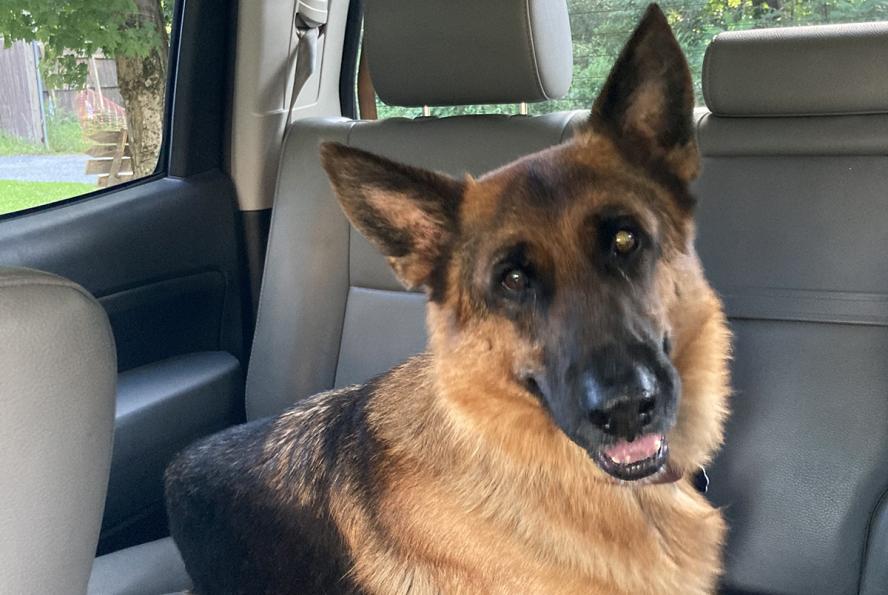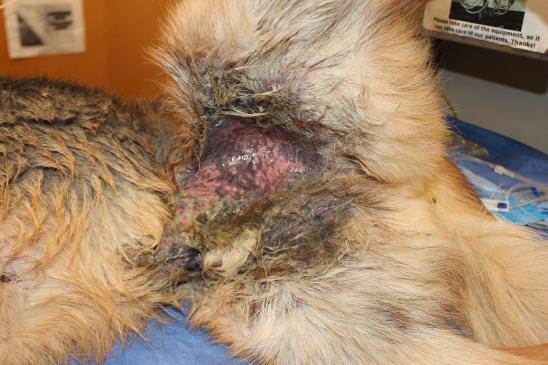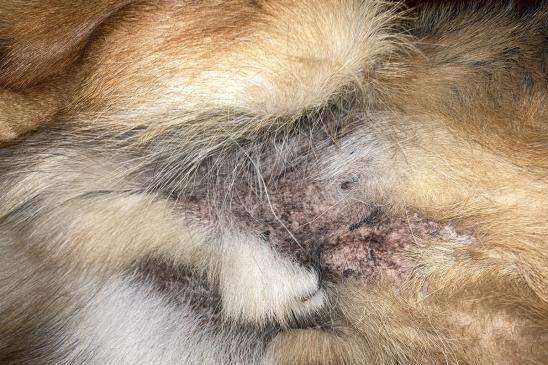-
About
- Leadership & Faculty
- News & Events
-
Academics
- Graduate
- Advanced Clinical Training
- Continuing Education
- Academic Departments
- Academic Offices
- Simulation Experiences
-
Student Life
- Offices
-
Research
-
Hospitals & Clinics
- Emergency Care
- Hospital Services
-
Community Outreach
- Volunteer
Clinical Case Challenge: German Shepherd with Recurrent Pyoderma
Lesions consistently returned after treatment

A German Shepherd named Buck presented to Henry and Lois Foster Hospital for Small Animals at Cummings School of Veterinary Medicine at Tufts University in significant pain with severe skin lesions spread over his body. He had been suffering from recurrent bouts of deep pyoderma for two years. The lesions disappeared with antibiotics and steroids but always recurred once treatment was discontinued. Buck became lethargic and was eating little. The lesions had become so painful, even with treatment, that his owners brought him to the Emergency Medicine and Critical Care (ECC) unit at Foster Hospital for Small Animals.
History
Buck arrived at the ECC in significant pain, with deeply inflamed lesions on his abdomen, groin, feet, face, and lips.
Under the care of his veterinarian, Buck had received several courses of antibiotic treatment (amoxicillin-clavulanate) and steroids. The infection cleared each time, but once taken off the medications, he relapsed. The referring veterinarian prescribed oclacitinib (Apoquel®) to help address pruritus (itchiness) and inflammation. The flares continued to recur, albeit less frequently, but worsened with each time. Buck’s infection ultimately became resistant to the antibiotics.
When his owner brought him to the ECC, he was not eating, seemed lethargic, and the severity of the lesions was causing much pain. The dermatology team at Foster Hospital for Small Animals took over his care.
Can you solve the case?
Determine which diagnostics and treatments are required
“We knew that he had an infection, but infection is always secondary to something else. You might not see the clinical signs of an underlying condition before you clear the infection,” said Dr. Ekaterina Mendoza-Kuznetsova, assistant clinical professor in the Department of Clinical Sciences.
The dermatology team observed deep ulceration, draining tracts, and crusts on Buck’s feet, groin, lips, ventral abdomen, and armpits.
“All lesions were so painful that examination was not possible without deep sedation and pain management,” said Mendoza-Kuznetsova.
The team diagnosed Buck with severe bacterial furunculosis, a form of deep pyoderma. The dermatology team took cultures from Buck’s skin and blood. The cytology results indicated numerous cocci bacteria from the inguinal lesions and cocci and rod-shaped bacteria from the feet. They needed to wait on the results of the culture to determine the most effective antibiotic. Meanwhile, they started treating Buck with empiric antibiotic clindamycin, topical antibacterial silver sulfadiazine cream, chlorhexidine shampoo, and pain control. Systemic antibiotics were required since the lesions were so deep.
Buck was suffering so acutely that he became aggressive, and the team had to anesthetize him to administer treatment. He spent three days at Foster Hospital for Small Animals on pain management medications and fluids, deeply sedated, until he was able to return home.
Buck continued to take clindamycin at home. The culture came back the following week, revealing four different types of bacteria. Based on these results, the team switched Buck to the antibiotic marbofloxacin.
The following week, Buck’s owner returned with him to the ECC. Buck was again in pain, and while the skin on his feet and lips had improved, the lesions in his armpits, groin, or abdomen had not.
Cytology taken from his paws and groin lesions showed the presence of only cocci infection, so it became clear that his current antibiotic marbofloxacin was effective against rod-shaped bacteria, but cocci infection was resistant to it. The team took another culture from the skin lesions and conducted tests to determine if parasitic disease could be an underlying cause of infection, as well as a skin biopsy to rule out skin neoplasia. They cleaned his skin with a biofilm-breaking medication and applied topical antibiotic cream. Buck additionally began a low dose of steroids to treat the inflammation. The team saw some improvement over the next few days as they awaited the results of the second culture and Buck was released home again.
The second culture indicated the cocci infection was now resistant to marbofloxacin. The team added a second antibiotic, cefpodoxime, to his treatment.
The following week, Buck improved markedly and his lesions began to heal. He continued the two antibiotics and a steroid. The following month, the lesions were near remission, his antibiotics were discontinued, and the team switched him from steroid to cyclosporine (Atopica®), an immunosuppressive anti-inflammatory medication.
When Buck returned to Foster Hospital for Small Animals three months later for a recheck, his lesions had fully healed—he had completely recovered, though he showed signs of allergies and pruritus. The team agreed he should be on cyclosporine long-term and added lokivetmab (Cytopoint®), an antipruritic medication.
Buck has fared well in the year since, continuing the two medications, without a relapse of the bacterial infection.
Comments from the Cummings School Dermatology Team
While skin infections are common in all dogs, pyoderma is frequently seen in dogs with allergies. German Shepherds may be predisposed to a particular form of pyoderma—deep, painful, and relapsing.
“Some German Shepherds are predisposed to have it so severely, they get it faster and more aggressively than other dogs,” said Mendoza-Kuznetsova. “It’s critical to remember that skin infection is always secondary to something else. It’s essential when the skin infection is cleared to look for an underlying disease, rather than reactively treating the infection with each relapse, or the skin infection will come back.”
Between episodes, Buck’s veterinarian had discontinued antibiotics and anti-inflammation medications, and the pyoderma continued to recur.
Veterinarians should remember to conduct a cytology test to determine the type of infection. Some infections need to be cultured before choosing an antibiotic. Since rod-shaped bacteria respond unpredictably to antibiotics, it’s necessary to have the culture results to make a definitive drug selection.
“Even with round-shaped (cocci) bacteria, if you see relapses, there’s a high chance of resistance developing from the bacteria,” said Mendoza-Kuznetsova. “It’s important to culture in such cases. If a patient undergoes several courses of antibiotics and keeps getting an infection, bacteria are likely developing resistance to the antibiotic and/or the underlying condition is not yet controlled. Culture first before choosing an antibiotic and always try to diagnose and control the underlying condition.”
Department:
Foster Hospital for Small Animals

